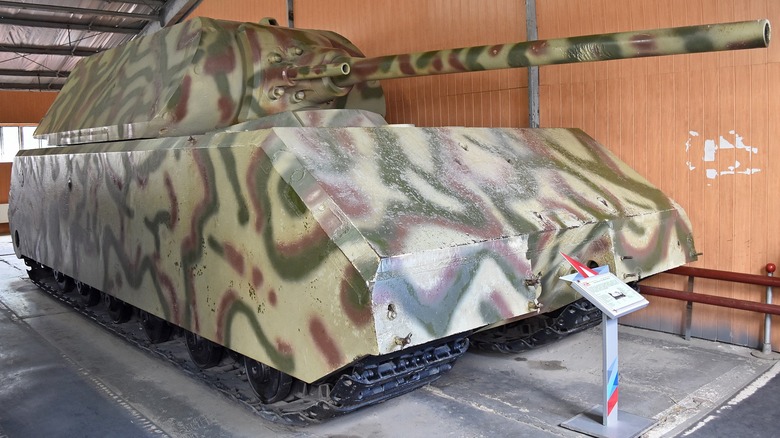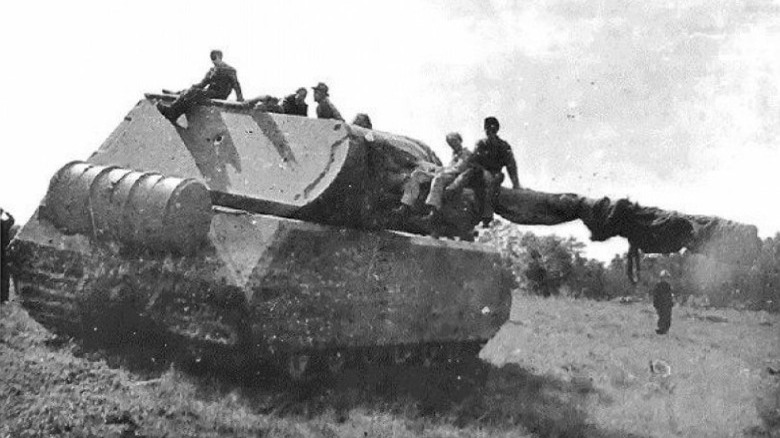The Massive Panzer Tank That Was Terribly Impractical
From nuclear bomb-dropping space shuttles to the most gargantuan gun ever used in combat, Adolph Hitler threw every idea he could think of at the wall to see what would stick during World War II. Some of the weapons devised by the Führer were as oversized as the man's ego, so when he set out to have Porsche build the biggest tank ever and call it a mouse — well, can anyone be all that shocked?
The debacle that was the Panzer VIII Maus (German for mouse) began its slog from idea to reality after Germany invaded the Soviet Union in June 1941. Despite several victories that resulted in the successful capture of vast areas of land, the Germans could not secure Moscow. As the Soviet defenses held firm, Hitler became convinced the war on the Eastern Front would drag on and a titanic tank was needed that could eventually break through Russian defenses and capture the city. The idea was that this tank would be both indestructible and wholly immune to enemy fire.
The Nazis' favorite big weapon builder, Krupp AG of Essen, soon began working on a super heavy tank inspired in part by the KV series of Soviet tanks. In March 1942, the German high command told Krupp to move forward with his designs for a 110-ton tank and to have it operational by the spring of 1943. Oddly, only two weeks later, on Hitler's say-so no less, Dr. Ferdinand Porsche — maker of Hitler's so-called People's Car – was approached to make the exact same tank.
[Featured image by Alan Wilson via Wikimedia Commons | Cropped and scaled | CC BY-SA 2.0]
A hulking tank built by Porsche
The Maus went through several iterations and was subjected to constant design changes during its development, the details of which would bore all but the most stalwart of World War II historians. The bottom line was that development was a tug of war between Hitler's desire for it to be bigger and more powerful than any other tank on the planet and the practical concerns of it actually being functional.
By all accounts, when Hitler ordered the creation of the Maus, Germany was in dire straights. His field marshal, Erwin Rommel — also known as the Desert Fox – was waging battle in North Africa, where strategic oil fields were located. The German army faced a limited fuel supply, was short on raw materials, and lacked the capacity and workforce to build the Maus.
The initial plan for the heavy tank required a lot of armor, a significant main canon, and at least one machine gun for close-quarter defense. Both Krupp and Porsche submitted designs, with Hitler picking Porsche's. Some historians think this was Hitler's way of offsetting some of Porsche's past design failures. In contrast, others believe Hitler put him in yet another position to fail by including the word "indestructible" in the actual tank requirements.
Whatever the case, Porsche was slated to develop the chassis and oversee the project, Krupp was tasked with producing the hull, turret, and guns. Meanwhile, Alkett, a manufacturer of armored fighting vehicles for the Wehrmacht, would put it all together.
This mouse could not escape its own trap
By May 1942, Hitler decided that 110 tons weren't enough, so he upped it to 132, and speed needn't be a factor. Porsche and Krupp continued to whip up revised plans based on Hitler's whims for everything from thicker armor to a deadlier main gun, a more prominent turret, no close-quarter machine guns, different engines, and internal hull arrangement.
Because the eventual final weight of the gluttonous AFV reached 188 tons, it was too heavy to cross most bridges. Thus, it had to also be an amphibious swimming tank able to cross rivers by driving through them. Hitler initially requested a fording requirement of 45 feet, but reality dictated a more practical 25 feet.
In the end, a total of six companies were involved with the building of Maus, many times butting heads. Aside from Porsche, Krupp, and Alkett, Daimler-Benz developed the engine, Siemens-Schuckert worked on the electrical system, and Škoda the suspension, tracks, and gearing. Hitler obviously never heard of having too many cooks in the kitchen.
To no one's surprise, his initial order of 150 was canceled in October 1943, and the project was shut down entirely on November 4. Still, two prototypes were built, tested, and evaluated well into 1944 that brought changes to several things, including the original Daimler-Benz engine, which was inadequate to move the monstrous weight of the tank. Today, the lone surviving prototype is on display at the Patriot Park Museum at Kubinka near Moscow.
[Image by Unknown Author via Wikimedia Commons | Cropped and scaled | CC BY Public Domain]

